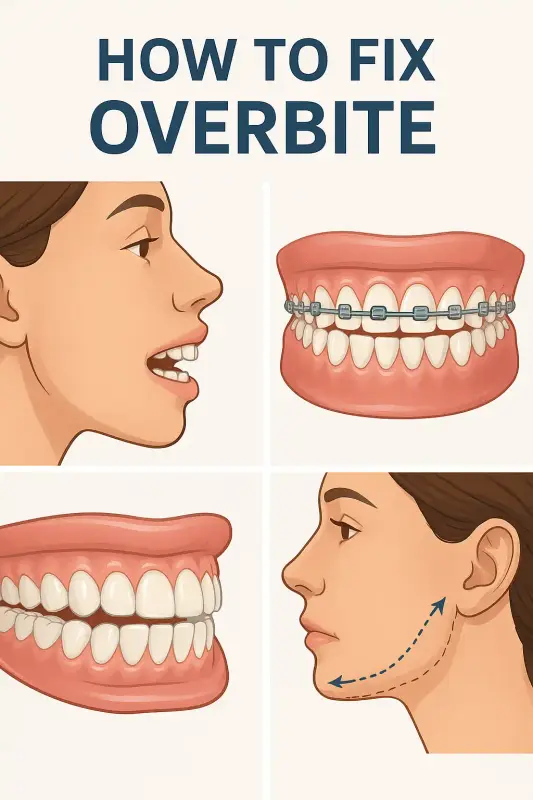How to Fix Overbite Naturally and Professionally – 13 Best Treatment Options

How to Fix Overbite Naturally and Professionally – 13 Best Treatment Options
An overbite—when the upper front teeth overlap the lower front teeth more than normal—is one of the most common dental issues worldwide. Whether caused by genetics, habits, or jaw alignment, knowing how to fix overbite can dramatically improve both your smile and oral health.
This comprehensive guide explores treatment options for kids, teens, and adults. It also covers natural techniques, medical procedures, and tips to prevent an overbite from worsening.
Understanding Overbite: Causes, Types, and Symptoms
What is an Overbite?
An overbite is a type of malocclusion, where the upper front teeth extend too far over the lower teeth. A slight overbite is normal, but excessive overlap can lead to:
- Jaw pain
- Tooth wear
- Gum issues
- Speech difficulties
Common Causes of Overbite
- Genetics: Often inherited from parents.
- Childhood habits: Thumb sucking, prolonged pacifier use, or tongue thrusting.
- Jaw development issues: Improper growth of upper/lower jawbones.
- Tooth loss: Missing teeth can cause others to shift, creating an overbite.
Types of Overbites: Dental vs. Skeletal
- Dental Overbite: Caused by misaligned teeth.
- Skeletal Overbite: Caused by a mismatch in jaw size or shape.
Symptoms and Long-Term Impact
Left untreated, an overbite can lead to:
- Headaches
- TMJ disorders
- Difficulty chewing
- Worn-down enamel
- A “gummy” smile or altered facial structure
How to Fix Overbite in Children and Teens
Braces and Retainers
Traditional braces are highly effective for correcting dental overbites in kids and teens. Braces apply gentle pressure to shift teeth over time. After braces, retainers help maintain alignment.
Growth Modification Devices
Used primarily in younger children, these devices guide jaw growth to prevent skeletal overbite formation. Examples include:
- Herbst appliance
- Headgear
- Palatal expanders
Early Orthodontic Intervention
The American Association of Orthodontists recommends children get evaluated by age 7. Early treatment can correct minor issues before they become major problems.
How to Fix Overbite in Adults
Invisalign and Clear Aligners
Invisalign and similar clear aligner systems offer a discreet way to fix overbites in adults. They work by:
- Gradually shifting teeth
- Applying force to reduce the overbite
- Requiring 20–22 hours/day of wear
Braces for Adults
Metal or ceramic braces are another effective option. Though visible, they offer powerful correction, especially for complex overbites.
Jaw Surgery (Orthognathic Surgery)
For severe skeletal overbites, jaw surgery may be needed to reposition the upper or lower jaw. This is typically combined with braces or aligners for full correction.
Tooth Extraction or Reshaping
In cases of overcrowding, tooth removal or reshaping may be necessary. This creates space and improves alignment.
Can You Fix Overbite Naturally Without Braces?
Myofunctional Therapy and Tongue Posture
These exercises train muscles involved in chewing, breathing, and swallowing. Benefits include:
- Improved tongue positioning
- Better lip seal
- Reduced pressure on teeth
Exercises to Correct Mild Overbites
- Jaw stretches
- Cheek muscle training
- Bite-closing drills
While these methods can’t fix skeletal overbites, they may improve muscle balance and oral habits.
Posture Correction and Oral Habits
Poor posture affects jaw alignment. Tips include:
- Keeping your back straight
- Breathing through the nose
- Avoiding mouth breathing
At-Home Tips to Prevent Overbite from Worsening
Avoiding Thumb Sucking and Pacifiers
Prolonged use beyond age 3 can misalign teeth and jaws. Gradual weaning and positive reinforcement are key.
Keeping Good Oral Hygiene
Tooth decay or early tooth loss can lead to shifting teeth and worsen overbites. Brush twice daily, floss, and schedule dental checkups.
Proper Chewing and Breathing Techniques
Chew food evenly on both sides. Encourage nose breathing to reduce jaw strain.
Before and After: Overbite Treatment Results
Real Stories and Visual Transformations
Patients who corrected overbites report:
- Higher confidence
- Better speech
- Less jaw pain
Visual changes often include:
- More symmetrical smile
- Improved jawline definition
- Balanced facial profile
Time Frame for Visible Results
- Braces: 12–24 months
- Invisalign: 6–18 months
- Surgery: 3–6 months recovery plus follow-up orthodontics
Costs and Insurance for Overbite Treatments
Average Costs for Braces and Aligners
| Treatment | Estimated Cost (USD) | | - | | | Metal Braces | $3,000 – $7,000 | | Invisalign | $3,000 – $8,000 | | Jaw Surgery | $20,000 – $40,000 |
What Dental Insurance Covers
Most insurance plans:
- Cover partial costs for braces
- Often exclude adult orthodontics
- May offer payment plans or FSA/HSA coverage
FAQs About How to Fix Overbite
Can overbite correct itself with age?
No. Most overbites worsen with time and require orthodontic treatment.
Is Invisalign better than braces for overbite?
For mild-to-moderate cases, yes. Braces are better for complex or severe issues.
Can you fix overbite without surgery?
Yes, if it’s dental and not skeletal. Braces or aligners can realign teeth effectively.
How long does it take to fix an overbite?
Anywhere from 6 months to 2 years depending on severity and method.
Will fixing overbite change face shape?
Yes. It often results in a more balanced profile, defined jawline, and improved smile.
Are overbites genetic?
Yes, but environmental factors and habits also play a role.
Conclusion: Take Control of Your Smile Today
Whether you’re a parent exploring treatment for your child or an adult ready to transform your smile, now you know how to fix overbite with confidence. From natural techniques to advanced orthodontics and surgery, every smile has a solution.
Now, I’ll generate 3–4 visuals to accompany this blog article.